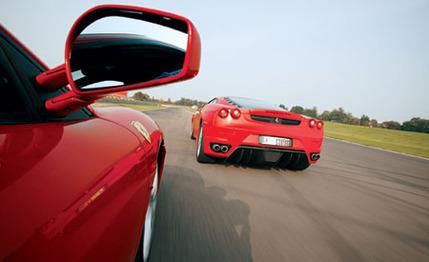 Road Test
Road Test
Scuderia Ferrari will have sealed its fifth consecutive Formula 1 drivers' championship and sixth consecutive constructors' championship well before your eyes glide across these words. Maybe it's time to turn down the voltage, coast for a while before even F1's impresario, Bernie Ecclestone, falls asleep.
Coasting isn't what management consultants would label a "core competency" at Ferrari. The black mare has been prancing at redline ever since current president and CEO Luca Cordero di Montezemolo kicked the door down in 1991. What had been a sleepy compound of squat red-brick workshops has become an Architectural Digest centerfold, the latest addition being Ferrari's Centro Sviluppo Prodotto, or Product Development Center. To his portfolio of wobbling spheres, coiled cobras, and fractured daggers, Italian architect Massimiliano Fuksas has added a sculpture of levitating smoked-glass cubes crowned by rooftop reflecting ponds. The water bugs zipping by as you navigate the narrow steel walkways between the buildings' wings now represent the bulk of Ferrari's nonunion workforce.
New Ferrari people, such as Mini Cooper chief designer Frank Stephenson, the director of Ferrari-Maserati Group design since August 2002, are busy fashioning the next generation of hero cars. Ferrari's latest entry-level model, the F430, is the first example to be publicly pinned on Stephenson (who shares the credit with design studio Pininfarina, which gets the body badge).
Carrying over much of its extruded aluminum space frame, suspension, interior layout, and longitudinal V-8 configuration, the F430 isn't considered a replacement for the 360 Modena so much as an evolution of it. Inside Ferrari, the 360 was called the F131, and the company ladled out about 10,000 servings. Although 70 percent of the parts are new and the price increase should be about $9500, to $167,000 with gas-guzzler tax, the F430 is called the F131 Evoluzione or, more simply, "the Evo" by Ferrari's engineers.
The 360 had looked fast, a crackling bonfire of Italian lust. But Stephenson believes it "was always a little flabby. It needed to go to the gym." The F430 went to the Enzo supercar for a few items, such as those blistered taillights and rear grille mesh. It worked out in the wind tunnel and received a new underbody winglet in the nose, air baffles on the otherwise smooth belly pan, a finned rear undertray, and a little whip of a tail spoiler. It all helps press the body down harder at speed. At 124 mph, the F430's axles carry about 100 more pounds than the 360's.
What purpose do the cartoon nostrils serve?
Back in 1961, Phil Hill won the F1 world championship in a Ferrari 156 that featured similar "shark nose" vents, Stephenson explains. So it's retro? "I hate that word retro," snaps the father of the new Mini. "We're carrying over our DNA, much like you have your grandmother's eyes or nose." Family genetics also spawned an industry called rhinoplasty, but that's neither here nor there.